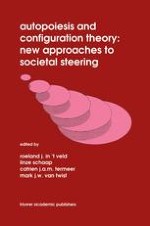1991 | Buch
Autopoiesis and Configuration Theory: New Approaches to Societal Steering
herausgegeben von: Roeland J. in ’t Veld, Linze Schaap, Catrien J. A. M. Termeer, Mark J. W. van Twist
Verlag: Springer Netherlands
Enthalten in: Professional Book Archive
